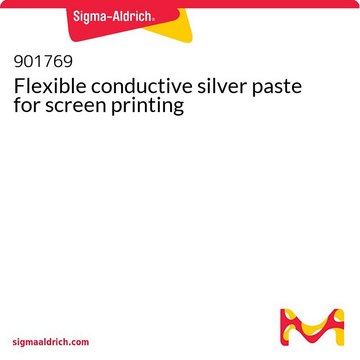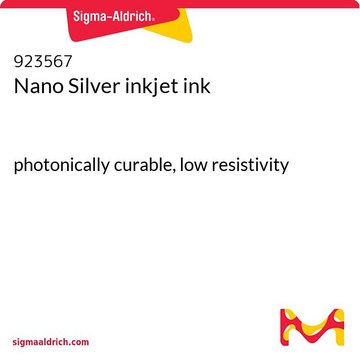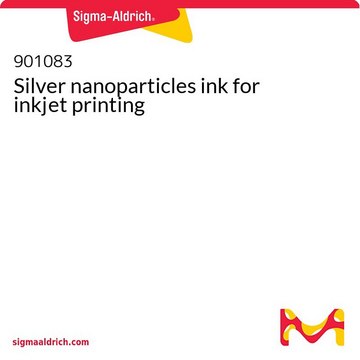923575
Silver nano ink
Screen printable, Photonically curable
Synonym(s):
Ag NP-based ink, Photonically curable Ag ink, S-CS21306, Screen printable Ag ink, Silver (Ag) Nanoparticle Ink, Silver nano ink
About This Item
Recommended Products
Quality Level
sheet resistance
15.6m Ω/sq, 25 mum after curing at 150 Celsius for 5 min on glass
7.5m Ω/sq, 25 mum after curing at 200 Celsius for 5 min on glass
75m Ω/sq, 25 mum after curing at 120 Celsius for 1h on glass
viscosity
6500-10000 mPa.s(20 °C) (@100/s)
storage temp.
2-8°C
Looking for similar products? Visit Product Comparison Guide
Application
Process: Rotary screen printing (below 80μm of resolution)
This ink has been developed to allow photonical curing to enable high throughput printing.
Compatible Printing Method: screen printing,
Compatible substrates: PET (Melinex 406, Melinex 339, Melines 520, Arcophane TCA, Arcophane STS, Folex BG-71), PEN (Teonex), Kapton® , Ceramic
Recommended surface treatment for substrates:
- Temperature stabilization
- Argon plasma treatment
Features and Benefits
- Good bending resistance, smooth surface
- Superior conductivity
- High resolution
- Curing process compatibility: photonic, NIR, low vacuum oven, thermal curing
- High nano-particle content
- Non-toxic (No CMR ink)
Preparation Note
- Inox, 18 µm mesh thickness, 640/inch-250/cm mesh count, 45 degree mesh angle, 7 µm emulsion thickness, 50 µm resolution, 83 m2/kg theoretical coverage, 1 µm theoretical dried thickness.
- Inox, 19 µm mesh thickness, 500/inch-200/cm mesh count, 22.5 degree mesh angle, 5 µm emulsion thickness, 40 µm resolution, 80 m2/kg theoretical coverage, 1 µm theoretical dried thickness.
- Polyester, 30 µm mesh thickness, 380/inch-150/cm mesh count, 22.5 degree mesh angle, 10 µm emulsion thickness, 80 µm resolution, 50 m2/kg theoretical coverage, 1.6 µm theoretical dried thickness.
Legal Information
Signal Word
Warning
Hazard Statements
Precautionary Statements
Hazard Classifications
Aquatic Acute 1 - Aquatic Chronic 1 - Eye Irrit. 2 - Skin Irrit. 2
Storage Class Code
10 - Combustible liquids
WGK
WGK 3
Certificates of Analysis (COA)
Search for Certificates of Analysis (COA) by entering the products Lot/Batch Number. Lot and Batch Numbers can be found on a product’s label following the words ‘Lot’ or ‘Batch’.
Already Own This Product?
Find documentation for the products that you have recently purchased in the Document Library.
Our team of scientists has experience in all areas of research including Life Science, Material Science, Chemical Synthesis, Chromatography, Analytical and many others.
Contact Technical Service









